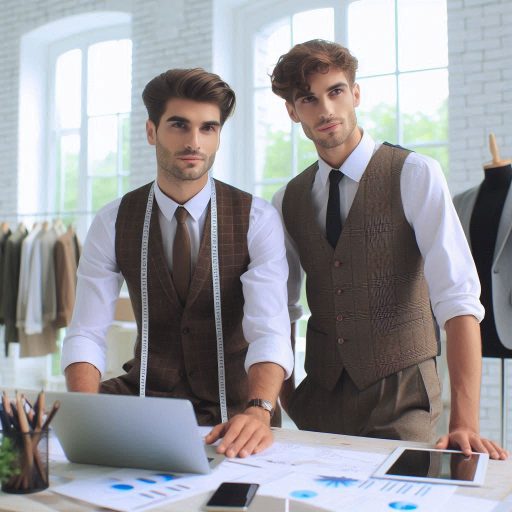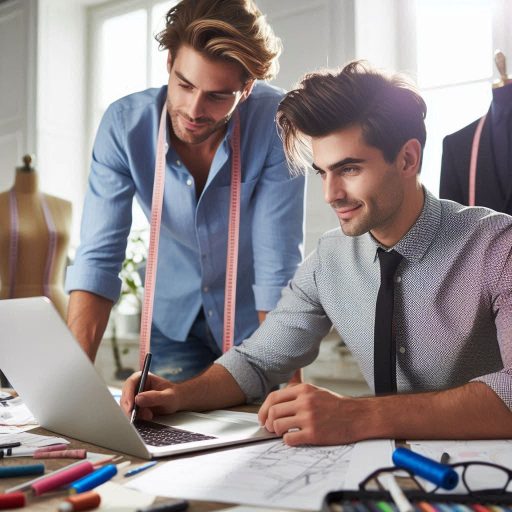Introduction
Collaboration in the fashion industry is a powerful catalyst for innovation and success.
By working with other designers, you open the door to a broader range of ideas and creative perspectives.
Such partnerships are essential for pushing the boundaries of conventional fashion design and exploring new stylistic avenues.
When designers collaborate, they blend unique styles, techniques, and visions, creating distinctive collections that resonate with diverse audiences.
Collaborating with other designers also presents numerous opportunities for growth.
It allows for the pooling of resources, which can reduce costs and make ambitious projects more feasible.
This collective approach enables experimentation with new concepts and materials that might be financially or logistically challenging on your own.
Additionally, collaborations can significantly expand your professional network, introducing you to new contacts, markets, and potential clients.
Moreover, collaborative efforts often attract increased media attention and consumer interest.
A well-executed partnership can generate buzz and elevate your brand‘s visibility.
Build Your Network
Attend fashion events, networking mixers, and fashion shows to meet other designers
Building a strong network is crucial for collaborating with other fashion designers.Start by attending fashion events, networking mixers, and fashion shows.
These venues offer opportunities to meet fellow designers and industry professionals.
Engaging in conversations at these events can help you establish valuable connections.
At fashion shows, observe how other designers present their work.Approach them with genuine interest in their designs and ideas.
Sharing your own experiences and inspirations can create a meaningful dialogue.
These interactions can lead to potential collaborations and partnerships.
Networking mixers provide a relaxed environment to interact with industry peers.Take the initiative to introduce yourself and discuss your work.
Exchange contact information to stay in touch after the event.
Follow up with a personalized message to solidify the connection.
Use social media platforms like Instagram and LinkedIn to connect with potential collaborators
Social media platforms are powerful tools for building your network.
Instagram and LinkedIn are especially useful for connecting with other designers.
On Instagram, follow designers whose work you admire. Engage with their posts by liking, commenting, and sharing your thoughts.
This can help you get noticed and open the door for future collaboration.
LinkedIn offers a more professional approach to networking. Create a compelling profile that highlights your work and achievements.
Join relevant fashion groups and participate in discussions. Connect with designers and industry professionals by sending personalized invitations.
Mention specific aspects of their work that you admire to make a positive impression.
Leverage your existing connections to expand your network further.
Ask colleagues and friends in the fashion industry for introductions.
Recommendations from trusted sources can enhance your credibility and facilitate new collaborations.
Building a network requires time and effort. Focus on creating genuine connections rather than simply collecting contacts.
Cultivate relationships with designers who share your vision and values.
Collaborations with like-minded individuals can lead to successful and fulfilling projects.
In summary, building your network is essential for successful collaborations with other fashion designers.
Attend events, use social media, and leverage existing connections to expand your network.
Approach each interaction with authenticity and professionalism.
By doing so, you can forge valuable relationships that enhance your career and open doors to exciting opportunities.
Read: Top Skills Needed for Art Educators and Instructors
Define Your Goals
Outline your objectives for collaborating with other designers
Before embarking on a collaboration with other fashion designers, clearly outline your objectives.
Establishing clear goals helps align expectations and ensures a successful partnership.
Reflect on what you hope to gain from this collaboration.This step is crucial for maximizing the benefits of working together.
Start by identifying your primary objective.
Are you seeking exposure in new markets or demographics? Perhaps you aim to learn new design techniques or gain a fresh perspective on your work.
Knowing your primary goal helps in selecting the right partners. Consider if you want to reach a broader audience.
Collaborating with designers who have established followings can boost your visibility.
This can introduce your work to new potential clients or fashion enthusiasts.
Increased exposure often leads to more opportunities and growth in your fashion career.
Another goal might be to expand your design techniques.
Working with designers who have different styles or specializations can enrich your own skill set.
You might learn new techniques or approaches that can enhance your designs.
This exchange of skills can be invaluable for personal and professional growth.
What do you hope to gain from the collaboration, whether it be exposure, new design techniques, or a new perspective
Be specific about what you hope to achieve.Instead of vague goals, set clear, measurable objectives.
For instance, if your goal is to learn new techniques, specify which techniques you want to master.
If exposure is your goal, outline the target audience or market you aim to reach.
Discuss these goals openly with your potential collaborators.Clear communication ensures that everyone is on the same page.
It also helps avoid misunderstandings or conflicts during the collaboration process.
Shared objectives foster a cooperative environment and contribute to a successful partnership.
Keep in mind that goals may evolve as the collaboration progresses.
Stay flexible and adapt your objectives as needed.
Regularly reassess your goals to ensure they align with the collaboration‘s progress and outcomes.
This adaptability helps in maintaining a productive and positive working relationship.
Defining your goals is a crucial step in collaborating with other fashion designers.
By outlining your objectives clearly, you set a solid foundation for a successful partnership.
Whether you seek exposure, new techniques, or a fresh perspective, clear goals will guide your collaboration and enhance its effectiveness
Read: Collaborating with Other Creative Roles
Research Potential Collaborators
Look for Designers Whose Style and Aesthetic Align with Yours
Finding designers who share a similar style and aesthetic can make collaboration more seamless.
Begin by analyzing their previous collections, design philosophies, and branding.
Evaluate how their work aligns with your own design vision.
Look for common threads in style, color palettes, and design techniques.
A shared aesthetic foundation can enhance cohesion in your collaborative projects.
Explore their portfolios to see if their design sensibilities complement yours.
If their work resonates with your vision, it indicates a potential for synergy.
Collaboration with designers who have a similar style can help ensure a unified and harmonious outcome.
This alignment is crucial for creating designs that both partners are proud of.
Consider Collaborating with Designers Who Bring a Different Perspective or Skillset to the Table
Diverse perspectives can significantly enhance the creative process. Seek out designers with different specialties or skills that complement your own.
For example, if you focus on womenswear, consider partnering with someone experienced in menswear or accessories.
Different skill sets can broaden the scope of your collaboration, offering new creative avenues.
A designer with a different background or expertise can bring innovative ideas and techniques to your projects.
Their unique perspective can challenge your design thinking and inspire new approaches.
Embrace this diversity to create something truly original and distinctive.
Evaluate Their Professional Reputation and Work Ethic
Before entering into any collaboration, assess the potential collaborator‘s professional reputation and work ethic.
Research their past projects and partnerships. Look for feedback from previous collaborators to gauge their reliability and professionalism.
Ensure they have a strong track record of meeting deadlines and maintaining a positive working relationship.
A designer with a solid reputation and a strong work ethic will contribute positively to the collaboration.
This ensures a smoother process and helps in achieving your shared goals effectively. Clear communication and mutual respect are crucial for a successful partnership.
Establish Clear Goals and Expectations
Once you have identified potential collaborators, establish clear goals and expectations for the partnership.
Discuss your vision, objectives, and roles in the project. Ensure both parties are on the same page regarding deadlines, responsibilities, and creative direction.
This clarity will help prevent misunderstandings and keep the collaboration focused and productive.
Researching potential collaborators involves looking for designers with aligned styles and aesthetics, as well as those who bring diverse perspectives and skills.
Evaluate their reputation and work ethic, and set clear goals for the partnership.
By following these steps, you can build successful and innovative collaborations in the fashion industry.
Read: Historic Costume Design Inspirations
Set Clear Expectations
Have open and honest conversations with your collaborators about roles, responsibilities, and deadlines
- Discuss Roles and Responsibilities: Begin with a discussion about each designer’s roles and responsibilities.
Clarify who handles what aspects of the project.
Make sure everyone understands their specific duties. This prevents overlap and confusion. - Address Concerns Early: Encourage open dialogue about any concerns or preferences.
Address these issues before the project starts. This promotes a smooth working relationship and prevents conflicts. - Define Contribution Levels: Clearly define the level of contribution expected from each designer.
Decide on the amount of time and effort each person will invest. This ensures fair workload distribution.
Establish a timeline and budget for the collaboration to ensure everyone is on the same page
- Create a Detailed Timeline: Develop a timeline outlining key milestones and deadlines. Break the project into manageable phases.
Assign due dates for each phase to keep the project on track. - Include Buffer Periods: Incorporate buffer periods in the timeline for unexpected delays.
This helps accommodate any unforeseen issues. It also reduces stress and allows for adjustments. - Regular Progress Check-Ins: Schedule regular meetings to review progress. This keeps everyone updated on the project’s status.
Address any issues promptly to stay on track.
Set a Budget
- Outline Financial Contributions: Determine the financial contributions required from each designer. Clearly outline who will cover which expenses.
This prevents financial disputes and ensures transparency. - Agree on Budget Limits: Set a budget limit for the entire project. Agree on how to manage costs if they exceed the initial budget.
This helps prevent overspending and ensures financial control. - Monitor Expenses: Track expenses regularly throughout the project. Keep detailed records of all expenditures.
This ensures that the project stays within budget and allows for timely adjustments.
Finalize Agreements
- Document Agreements: Put all agreed-upon terms in writing. Create a formal document detailing roles, deadlines, and budget.
This provides a reference point for all parties involved. - Review and Sign Contracts: Review the document together and make necessary adjustments. Have all collaborators sign the contract.
This formalizes the agreement and ensures commitment from all parties. - Update as Needed: Be prepared to update agreements if circumstances change. Discuss and document any modifications to the timeline or budget.
This maintains clarity and prevents misunderstandings.
Setting clear expectations through open communication, detailed timelines, and defined budgets fosters successful collaborations.
By addressing these aspects early on, you ensure a smooth and productive working relationship with fellow designers.
Read: Breaking Down Iconic Movie Costumes

Embrace Creative Differences
Understand that collaborating with other designers may lead to creative disagreements
When working with other designers, expect creative disagreements. Different design philosophies and visions can clash.
This is a natural part of the collaboration process. Approach these disagreements with an open mind and willingness to listen.
Use these differences to your advantage by challenging each other and pushing boundaries
Creative differences can be a catalyst for innovation. Use disagreements as opportunities to challenge each other‘s ideas.
Ask questions that prompt deeper thinking. Push each other to explore new design concepts and techniques. This will lead to unique and unexpected outcomes.
Encourage Open Dialogue
Maintain open dialogue throughout the collaboration. Share your perspectives clearly and respectfully.
Listen actively to your collaborator‘s ideas and feedback. Open communication helps resolve conflicts and fosters a productive environment.
Transform Your Career Today
Unlock a personalized career strategy that drives real results. Get tailored advice and a roadmap designed just for you.
Start NowFind Common Ground
Identify areas where your creative visions align. Focus on these common goals to guide the collaboration.
Establish shared objectives that incorporate elements from both designers‘ styles. This can create a cohesive and innovative final product.
Push Boundaries Together
Use your combined creative energies to push boundaries. Explore unconventional materials, techniques, and design elements.
Embrace the risk of venturing outside traditional norms.
This approach can lead to groundbreaking fashion collections that stand out in the industry.
Conclude with Reflection
After completing a project, reflect on the collaboration experience. Discuss what worked well and what could be improved.
Use this feedback to enhance future collaborations and continue growing as a designer.
By embracing creative differences, you turn potential challenges into opportunities for growth and innovation.
Use these strategies to make the most of your collaborative efforts and achieve outstanding results in your fashion projects.
Communicate Effectively
Effective communication is essential for successful collaboration with other fashion designers.
It ensures that everyone involved stays aligned with the project’s vision and goals.
Here‘s how to maintain open lines of communication and keep the collaboration process smooth:
Maintain open lines of communication with your collaborators throughout the process
- Establish Clear Channels: Decide on the main communication platforms for your project.
Options include email, instant messaging apps, or project management tools. - Share Contact Information: Ensure that all team members have each other’s contact details. This prevents delays caused by communication barriers.
- Set Regular Updates: Schedule consistent check-ins to discuss progress. This helps prevent misunderstandings and keeps everyone on the same page.
- Be Transparent: Share important information and updates promptly. Transparency builds trust and fosters a cooperative environment.
- Encourage Feedback: Create an open environment where feedback is welcomed. Constructive criticism helps improve the design process.
Regularly check in with each other to ensure everyone is on track and happy with the progress
- Plan Regular Meetings: Set up weekly or bi-weekly meetings to review progress. Use these meetings to address any issues and align on next steps.
- Use Meeting Agendas: Prepare agendas for each meeting. This ensures discussions are focused and time-efficient.
- Document Discussions: Keep records of decisions and action items from meetings. This documentation helps track progress and responsibilities.
- Address Concerns Promptly: If issues arise, address them quickly. Delayed resolutions can hinder progress and affect team morale.
- Celebrate Milestones: Acknowledge achievements and progress. Celebrating milestones boosts team motivation and reinforces positive collaboration.
Effective communication fosters a collaborative spirit and ensures that the fashion design project progresses smoothly.
By maintaining open lines of communication and regularly checking in, you can keep the project on track and ensure all collaborators are satisfied with the progress.
Clear and consistent communication helps build strong working relationships, leading to a successful and enjoyable collaboration experience.
Learn More: How to Build a Strong Design Portfolio
Promote the Collaboration
Once the collaboration is complete, showcase the work on social media, your website, and in press releases
Once the collaboration is complete, it’s crucial to promote it effectively. Start by showcasing the work on social media.
Use platforms like Instagram, Facebook, and Pinterest to highlight the final product. Create engaging posts that capture the essence of the collaboration.
Share behind-the-scenes photos to offer insight into the creative process. This helps build excitement and engages your audience with authentic content.
Use hashtags strategically to increase visibility. Popular fashion-related hashtags can attract more attention from the fashion community.
Tag the designers involved to give credit where it‘s due. This encourages their followers to engage with your content as well.
Posting consistently across social platforms ensures your audience remains interested and updated.
Respond to comments and questions to foster conversation and build engagement.
Your website is another powerful tool for promotion. Dedicate a section to the collaboration, featuring high-quality images and detailed descriptions of the project.
Showcase the unique aspects of the partnership, emphasizing how the designers’ strengths complemented each other.
Highlight the creative synergy that made the collaboration special.
Press releases also offer a professional way to spread the word. Distribute them to relevant fashion magazines, blogs, and industry websites.
Include quotes from both parties involved in the collaboration.
The collaborative process give credit to all parties involved
Collaborations gain more traction when you emphasize the collaborative process itself. Don’t just focus on the final product; share the journey.
Detail how you and the other designer worked together to achieve the shared vision.
This adds depth to the project and makes the collaboration more relatable to your audience.
When promoting, always give proper credit to all parties involved. Mention your collaborators in every post and feature their logos or branding.
Acknowledge their contributions, which fosters goodwill and strengthens future partnerships.
Giving credit is a vital aspect of maintaining professional relationships in the fashion industry.
Finally, consider hosting an online or in-person event to showcase the collaboration.
Fashion shows, virtual exhibitions, or pop-up shops offer a dynamic way to present the work to a broader audience.
By promoting the collaboration thoughtfully, you ensure it gains the recognition it deserves.
Effective promotion benefits all parties involved, elevating their brands and expanding their reach.
Reflect on the Experience
Take time to reflect on the collaboration and evaluate what worked well and what could be improved
Reflecting on your collaboration is crucial for growth as a designer. Start by taking time to assess the partnership.
Reflect on what worked well and what did not. This process will help you understand the dynamics of your collaboration.
Begin by evaluating the strengths of the project. Consider aspects that led to successful outcomes.
Was it the synergy between designers? Or was it the clarity of roles and communication? Identify these elements.
Next, analyze the challenges faced during the collaboration. Look at what hindered progress or caused friction.
Were there misunderstandings about responsibilities? Did differences in design vision affect the outcome? Understanding these issues helps in learning from them.
Gather feedback from your collaborators. Ask for their insights on what they felt worked and what didn‘t.
This feedback provides a broader perspective on the collaboration‘s effectiveness. It also helps you see things you might have missed.
Showcase Your Business Today
Reach thousands of readers actively exploring professional services. Publish your business profile and grow your audience now.
Publish NowCompare the feedback with your own reflections. Look for common themes or patterns in both your views and theirs.
This comparison helps in understanding the overall success and areas needing improvement.
Document your reflections and feedback. Create a summary of key points that impacted the collaboration.
This record will be useful for future projects. It also serves as a reference for tracking your growth as a designer.
Use this feedback to inform future collaborations and continue to grow as a designer
Use the insights gained to inform future collaborations. Apply the lessons learned to enhance your next partnership.
If clear communication was a challenge, work on improving it. If role clarity was an issue, set clearer boundaries and expectations.
Seek opportunities to apply your new understanding. Engage in projects where you can test and refine the improvements.
Continuously integrating feedback helps in evolving as a designer. It fosters better collaboration and innovative outcomes.
Regularly reflect on your collaborative experiences. This ongoing evaluation keeps you aware of your growth areas.
It also helps you adapt to new challenges and opportunities.
Remember, every collaboration is a learning experience. Embrace both successes and failures as steps in your growth journey.
Use each experience to refine your approach and enhance your skills.
By reflecting on each collaboration, you build a solid foundation for future partnerships.
This practice not only improves your collaboration skills but also enriches your design career.
Conclusion
Collaboration plays a crucial role in the fashion industry, driving creativity and innovation.
By working together, designers can blend unique styles and perspectives to create something truly original.
Collaboration allows you to expand your design capabilities by learning new techniques and gaining fresh insights from other creatives.
It’s an excellent way to push boundaries and discover new ideas that you may not have considered on your own.
Beyond the creative benefits, collaboration also helps in expanding your professional network.
Building relationships with other designers can open up opportunities for future partnerships, shared projects, and even mentorship.
These connections are invaluable in a competitive industry where who you know can be just as important as what you know.
To truly thrive in the fashion world, it’s essential to seek out opportunities to collaborate.
Not only does it enhance your skills, but it also strengthens your reputation and visibility.
By working together, you set yourself up for long-term success in the industry.
[E-Books for Sale]
The Big Book of 500 High-Paying Jobs in America: Unlock Your Earning Potential
$19.99 • 500 High-Paying Jobs • 330 pages
Explore 500 high-paying jobs in America and learn how to boost your career, earn more, and achieve success!
See All 500 High-Paying Jobs of this E-Book
1001 Professions Without a Degree: High-Paying American Jobs You Can Start Now
$19.99 • 1001 Professions Without a Degree • 174 pages
Discover 1001 high-paying jobs without a degree! Unlock career tips, skills, and success strategies for just $19.99!




